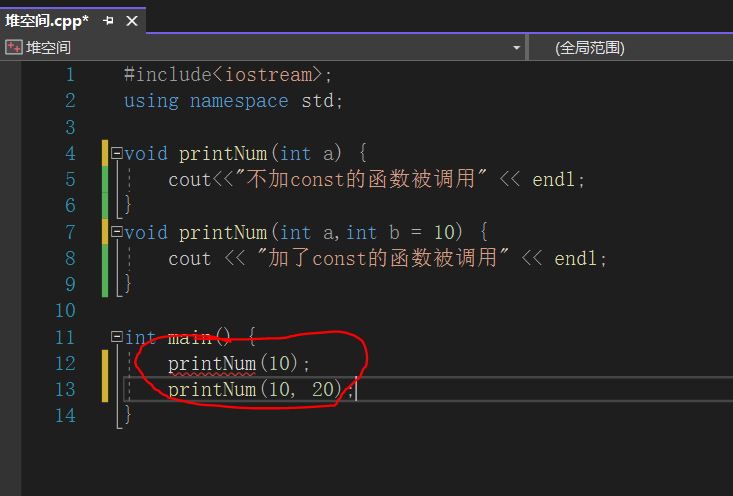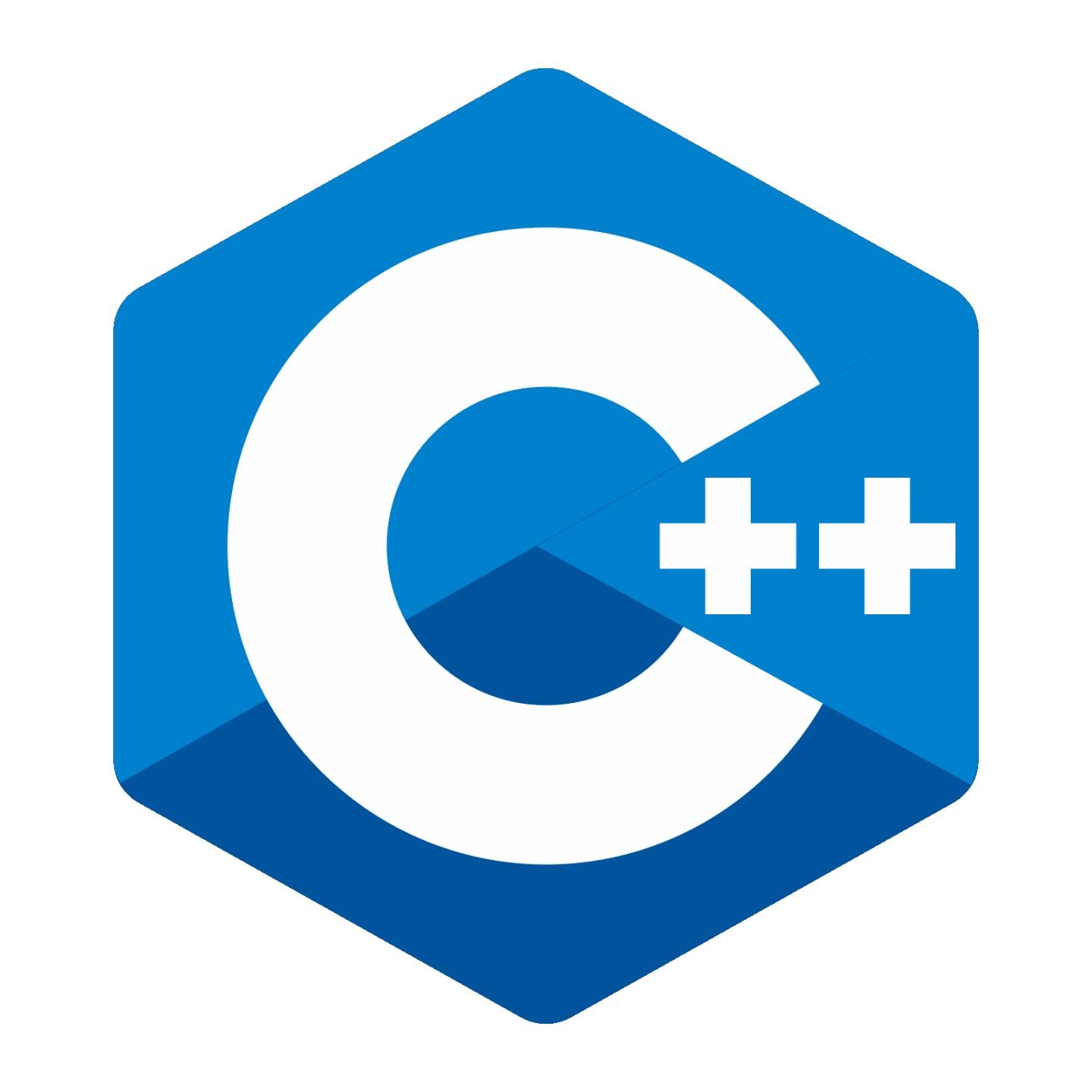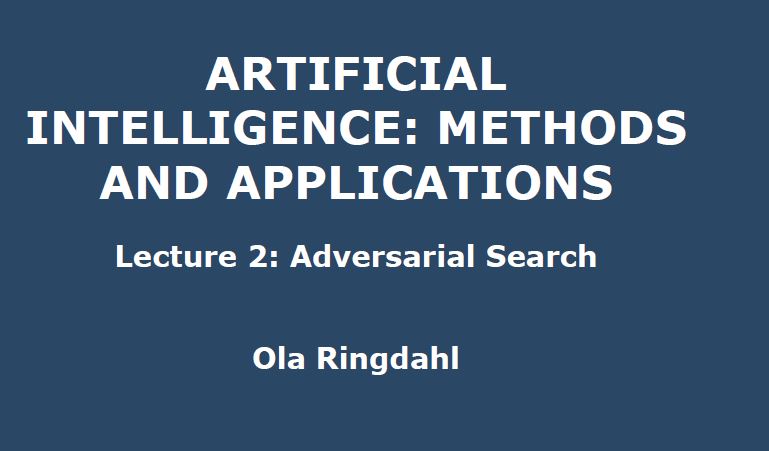前言
b站C++课程学习笔记整理。
b站视频: 黑马程序员匠心之作|C++教程从0到1入门编程,学习编程不再难
84-88. 内存四区和new的用法
C++程序在执行时,将内存分为四个区:
- 编译后:
- 代码区:存放函数体的二进制代码,由操作系统进行管理。
- 全局区:存放全局变量和静态变量以及全局常量(常量由const修饰)。
- 程序运行后:
- 栈区:由编译器自动分配释放,存放函数的参数值,局部变量等。
- 堆区:由程序员分配和释放,若程序员不释放,程序运行后自动释放。
总结:
- 局部的在栈区,全局的在全局区。
- 和Java类似。只不过Java没有指针的功能。
- 不要返回局部变量的地址,因为局部的变量在函数执行完后已经被编译器释放了(但是我VS2022没报错并成功了不知道为啥)。
- 可以使用
new关键字开辟堆空间(类似于Java)。这个可以返回地址。
- 可以使用
delete关键字释放堆空间。
感觉是新版的编译器对这个地方做了很多的优化。
int* p = new int(10);注意new出来的是返回的地址,要用指针接收。
89- 90. 引用
91. 引用做函数参数
作用:函数传递时,可以利用引用的技术让形参修饰实参。
优点:可以简化地址传递修改实参。
其实引用的nickname也是指针。和指针的区别是他可以直接用,不需要解引用*p。
示例代码:
1
2
3
4
5
6
7
8
9
10
11
12
13
14
15
16
17
18
19
20
21
22
23
24
25
26
27
28
29
30
| #include<iostream>;
using namespace std;
void swap1(int* p_a,int* p_b) {
int temp = *p_a;
*p_a = *p_b;
*p_b = temp;
}
void swap2(int &c,int &d) {
int temp = c;
c = d;
d = temp;
}
int main() {
int a = 10;
int b = 20;
cout << "调用前a是" << a << "\tb是" << b << endl;
swap1(&a, &b);
cout << "调用后a是" << a << "\tb是" << b << endl;
int c = 10;
int d = 20;
cout << "调用前c是" << c << "\td是" << d << endl;
swap2(c,d);
cout << "调用后c是" << c << "\td是" << d << endl;
return 0;
}
|
92. 引用做函数的返回值
- 不要返回局部变量的引用。
- 函数的调用可以作为左值。
示例代码:
1
2
3
4
5
6
7
8
9
10
11
12
13
| #include<iostream>;
using namespace std;
int& printNum(int& a) {
return a;
}
int main() {
int a = 0;
printNum(a) = 20;
cout << a << endl;
return 0;
}
|
93. 引用的本质
本质:引用的本质在c++内部实现一个指针常量(指针指向的位置不可改,指针指向的值可以改)。
94. 常量引用
常量引用主要用来修饰形参,防止误操作。
在函数形参列表中,可以加const修饰形参,防止形参改变实参。
const int& ref = 10代表着int temp = 10; const int& ref = temp;
使用const修饰形参防止误操作:
1
2
3
4
5
6
7
8
9
10
11
12
13
| #include<iostream>;
using namespace std;
void printNum(const int& a) {
cout <<"形参为" << a << endl;
}
int main() {
int a = 0;
printNum(a);
cout <<"实参为"<< a << endl;
return 0;
}
|
95. 函数默认参数
c++中函数形参可以有默认值。
注意的点:
- 如果某个位置已经有了默认参数,那么从超过这个位置往后从左到右都必须由默认值。
- 如果函数声明有默认参数,函数的实现就不能有默认参数。声明和实现只能有一个有默认参数。
96. 函数占位参数
C++中函数的形参列表里可以有占位参数,用来做占位,调用时必须填补这个位置。占位参数可以有默认参数。
语法:返回值类型 函数名(数据类型){}
示例代码:
1
2
3
4
5
6
7
8
9
10
11
12
13
14
15
| #include<iostream>;
using namespace std;
void printNum(int a, int) {
}
void printNum2(int a, int = 10) {
}
int main() {
int a = 0;
printNum(a,10);
printNum2(a);
return 0;
}
|
97. 函数重载
就是Java中的方法重载,一样的。
98. 函数重载注意事项
当引用作为重载条件:
1
2
3
4
5
6
7
8
9
10
11
12
13
14
15
16
17
| #include<iostream>;
using namespace std;
void printNum(int &a) {
cout<<"不加const的函数被调用" << endl;
}
void printNum(const int &a) {
cout << "加了const的函数被调用" << endl;
}
int main() {
int a = 10;
printNum(a);
printNum(10);
return 0;
}
|
尽量避免函数重载碰到函数默认参数产生二义性:

99-100. 类和对象-封装-属性和行为做为整体
面向对象的三大特征:封装、继承和多态。
封装:将属性和整体作为一个整体,表现生活中的事物。
语法:class 类名 { 访问权限: 属性 / 行为}。
跟Java区别是权限符是在类里面写的。
示例:设计一个学生类,包含姓名学号get, set方法等(经典老番)。
1
2
3
4
5
6
7
8
9
10
11
12
13
14
15
16
17
18
19
20
21
22
23
24
25
26
27
28
29
30
31
32
33
34
35
36
37
38
39
40
41
42
43
| #include<iostream>;
using namespace std;
class student {
public:
string s_name;
int s_age;
student() {}
student(string name, int age) {
s_name = name;
s_age = age;
}
void setName(string name) {
s_name = name;
}
void setAge(int age) {
s_age = age;
}
string getName() {
return s_name;
}
int getAge() {
return s_age;
}
void study() {
cout << "学生可以学习" << endl;
}
};
int main() {
student s1;
student* p= new student("孙健耕", 21);
s1 = *p;
cout << "年龄是" << s1.getAge() << endl;
student s2 = student("孙健耕", 22);
cout << "年龄是" << s2.getAge() << endl;
}
|
101. 访问权限
102. class和struct区别
其实这俩功能很像。唯一区别:
struct默认是public。class默认是private。
103. 成员属性设置为私有
优点:可以自己控制读写权限。对于写权限,可以查看数据的有效性。
106. 对象的初始化和清理
初始化:构造函数。
清理对象的内容:析构函数。
编译器会默认提供一个默认的空的构造函数和空的析构函数。
107. 构造函数的分类和调用
两种分类方式:
- 按参数,分为:有参构造和无参构造。
- 按类型,分为:普通构造和拷贝构造。
三种调用方法:
注意:使用无参构造的时候不要写小括号,否则编译器会认为这是一个函数的声明。
示例代码:
1
2
3
4
5
6
7
8
9
10
11
12
13
14
15
16
17
18
19
20
21
22
23
24
25
26
27
28
29
30
31
32
33
34
35
36
37
38
39
40
41
42
43
44
45
46
47
48
49
50
51
52
53
| #include <iostream>
using namespace std;
class student
{
public:
string s_name;
int s_age;
student() {
cout << "无参方法被调用" << endl;
};
student(string name,int age) {
cout << "带参方法被调用" << endl;
};
student(string name) {
cout << "带参方法被调用" << endl;
};
~student() {
cout << "析构函数被调用" << endl;
};
student(const student &s) {
s_name = s.s_name;
s_age = s.s_age;
cout << "拷贝方法被调用" << endl;
};
};
int main(){
student s1;
student s2("孙健耕", 21);
student s3(s2);
student s4 = student();
student s5 = student("孙健耕", 21);
student s6 = student(s5);
student();
system("pause");
return 0;
}
|
108. 拷贝构造函数的调用
C++中拷贝构造函数调用的时机通常有三种情况
- 使用一个已经创建完毕的对象来初始化一个新对象
- 值传递的方式给函数参数传递
- 以值方式返回局部对象
比如以下代码,调用了三次拷贝函数。
1
2
3
4
5
6
7
8
9
10
11
12
13
14
15
16
17
18
19
20
21
22
23
24
25
26
27
28
29
30
31
32
33
34
35
36
37
38
39
40
41
42
43
44
| #include <iostream>
using namespace std;
class student
{
public:
string s_name;
int s_age;
student() {
cout << "无参方法被调用" << endl;
};
student(string name,int age) {
cout << "带参方法被调用" << endl;
};
student(string name) {
cout << "带参方法被调用" << endl;
};
~student() {
cout << "析构函数被调用" << endl;
};
student(const student &s) {
s_name = s.s_name;
s_age = s.s_age;
cout << "拷贝方法被调用" << endl;
};
};
student doWork(student s) {
return s;
};
int main(){
student s1;
student s2(s1);
doWork(s1);
system("pause");
return 0;
}
|
109. 构造函数的调用规则
默认情况下,编译器至少给一个类添加三个函数
- 默认构造函数(无参,函数体为空)。
- 默认析构函数(无参,函数体为空)。
- 默认拷贝构造函数,对属性进行值拷贝。
- 和Java一样,如果用户定义有参构造,c++不会提供无参构造,但是会提供一个拷贝。
- 如果用户定义拷贝构造,那C++不会提供任何别的默认构造方式了。
110. 深拷贝与浅拷贝

解决:使用自定义的拷贝函数进行深拷贝。
1
2
3
4
5
6
7
8
9
10
11
12
13
14
15
16
17
18
19
20
21
22
23
24
25
26
27
28
29
30
31
32
33
34
35
36
37
38
39
| #include <iostream>
using namespace std;
class student {
public:
string s_name;
int* s_age;
student() {
cout << "无参构造" << endl;
}
student(string name,int age) {
cout << "带参构造" << endl;
s_name = name;
s_age = new int(age);
}
student(const student &s) {
s_name = s.s_name;
s_age = new int(*s.s_age);
}
~student() {
cout << "析构函数" << endl;
if (s_age != NULL) {
delete s_age;
s_age = NULL;
}
}
};
void test() {
student s1("孙健耕", 21);
student s2(s1);
}
int main() {
test();
system("pause");
return 0;
}
|
111. 初始化列表
作用:
C++提供了初始化列表的语法,用来初始化属性。
语法:构造函数(): 属性1(值1),属性2(值2) ...{}
示例代码:
1
2
3
4
5
6
7
8
9
10
11
12
13
14
15
16
17
18
19
20
21
22
23
24
| #include <iostream>
using namespace std;
class student {
public:
string s_name;
int s_age;
student(string name, int age) :s_name(name), s_age(age) {
cout << "初始化列表构造方法被调用" << endl;
}
};
void test() {
student s1("孙健耕", 21);
cout << s1.s_age << s1.s_name << endl;
}
int main() {
test();
system("pause");
return 0;
}
|
112. 类对象作为类成员
C++类中的成员可以实另一个类的对象。
例如:
1
2
3
4
| class A{}
class B{
A a;
}
|
当创建B对象时,A与B的构造与析构的顺序是?
构造:先创建一个A类对象,再来构造B类。
析构:先析构B类,再析构A类。
113. 静态成员
分为静态成员变量和静态成员函数。
- 静态成员变量
- 所有对象共享同一份数据
- 再编译阶段分享内存
- 类内声明,类外初始化
比如:动态的是不同的对象之间可能不同的数据。静态的是不同的对象间肯定相同的数据。const是不同对象间肯定相同,且无法修改的数据。
示例代码:
1
2
3
4
5
6
7
8
9
10
11
12
13
14
15
16
17
18
19
20
21
22
23
| #include <iostream>
using namespace std;
class student {
public:
static string s_name;
};
string student::s_name = "Kalle";
void test() {
student s1;
cout << s1.s_name << endl;
student s2;
s2.s_name = "Jack";
cout << s1.s_name << endl;
cout << student::s_name << endl;
}
int main() {
test();
system("pause");
return 0;
}
|
- 静态成员函数
- 所有对象共享同一个函数
- 静态成员函数只能访问静态成员变量
为什么静态成员函数只能访问静态成员变量?因为静态成员函数是共享的,当调用时,如果访问动态成员变量,那他就不知道该访问哪个对象的动态成员变量了。
示例代码:
1
2
3
4
5
6
7
8
9
10
11
12
13
14
15
16
17
18
19
20
21
22
23
24
25
26
27
28
29
| #include <iostream>
using namespace std;
class student {
public:
static string s_name;
static void dowork() {
s_name = "Jack";
}
};
string student::s_name = "Kalle";
void test() {
student s1;
cout << s1.s_name << endl;
student::dowork();
cout << s1.s_name << endl;
}
int main() {
test();
system("pause");
return 0;
}
|
注意,静态成员方法是可以有访问权限要求的。
114. 成员变量和成员函数分开存储
在C++中,类内的成员变量和成员函数分开存储,只有非静态的成员变量才属于类的对象上。
- 空对象(类是空的)占一个字节(目的是区分不同的空对象)。
- 非对象中:
- 成员变量按类型占相应的字节。(比如一个int占4个,两个int成员变量占8个)
- 成员方法、以及静态的变量和方法都不属于类的对象上。
示例代码:
1
2
3
4
5
6
7
8
9
10
11
12
13
14
15
16
17
18
19
| #include <iostream>
using namespace std;
class student {
public:
int name;
int age;
};
void test() {
student s1;
cout << sizeof(s1) << endl;
}
int main() {
test();
system("pause");
return 0;
}
|
115. this指针的用途
- 解决变量重名(和Java一样)。不同的是C++里this是指针,指向的是调用这个指针的对象。所以应该用指针的方式去使用this。例如:
this->name = name
- 利用解引用的方式返回本体。 例如:
return *this;
示例代码:
1
2
3
4
5
6
7
8
9
10
11
12
13
14
15
16
17
18
19
20
21
22
23
24
25
26
27
28
29
30
31
32
33
| #include <iostream>
using namespace std;
class student {
public:
int age;
student(int age) {
this->age = age;
}
student& addAge(student &s) {
this->age += s.age;
return *this;
}
};
void test() {
student s1(10);
cout << s1.age << endl;
}
void test2() {
student s2(10);
student s3(10);
s2.addAge(s3).addAge(s3).addAge(s3).addAge(s3).addAge(s3);
cout << s2.age << endl;
}
int main() {
test2();
system("pause");
return 0;
}
|
注意在返回自身的引用的函数addAge中,
- 参数使用引用的方式,是因为这样做不需要调用系统的默认浅拷贝函数,直接通过引用(本质是个指针),进行地址操作,节省空间。
- 返回值使用引用的方式,是因为这样做不需要调用系统的默认浅拷贝函数。否则就会返回一个拷贝后的新的
student,虽然和s2是一模一样,但是他们本质上是两个对象。这样的返回值是20,而不是正确的60。
116. 空指针访问成员函数
C++中空指针也是可以调用成员函数的,但是要注意有没有用到this指针。如果用到了this指针,就要判断一下,保证代码的健壮性。
1
2
3
4
5
6
7
8
9
10
11
12
13
14
15
16
17
18
19
20
21
22
23
24
25
26
27
28
29
30
31
32
33
34
35
36
| #include <iostream>
using namespace std;
class student {
public:
int age;
student(int age) {
this->age = age;
}
void showAge() {
cout << "成员函数被调用" << endl;
}
void showAge1() {
if (this == NULL) {
return;
}
cout << age << endl;
}
};
void test() {
student* p = NULL;
p->showAge();
p->showAge1();
}
int main() {
test();
system("pause");
return 0;
}
|
117. const修饰成员函数
常函数:
- 成员函数后加
const后称这个函数为常函数
- 常函数内不可以修改成员属性
- 成员属性加
mutable关键字后,依然可以修改
常对象:
- 声明对象前加
const称该对象为常对象
- 常对象只能调用常函数
示例代码:
1
2
3
4
5
6
7
8
9
10
11
12
13
14
15
16
17
18
19
20
21
22
23
24
25
26
27
28
29
30
31
32
33
34
35
36
37
38
39
40
| #include <iostream>
using namespace std;
class student {
public:
int age;
mutable int number;
student(int age,int number) {
this->age = age;
this->number = number;
}
void showAge() const{
number = 20;
this->number = 30;
}
void showAge1() {
}
};
void test() {
const student s = student(10,20);
s.showAge();
s.number = 20;
}
int main() {
test();
system("pause");
return 0;
}
|
118. 友元
在程序里,有些私有属性,也想让类外特殊的一些函数或者类进行访问,这时就需要友元技术。
关键字friend。
三种实现:
1
2
3
4
5
6
7
8
9
10
11
12
13
14
15
16
17
18
19
20
21
22
23
24
25
26
27
| #include <iostream>
using namespace std;
class building {
friend void myFriend(building& b);
public:
string sittingroom;
private:
string bedroom;
public:
building() {
sittingroom = "客厅";
bedroom = "卧室";
}
};
void myFriend(building &b) {
cout << "正在访问:" << b.sittingroom<<endl;
cout << "正在访问:" << b.bedroom << endl;
}
int main() {
building b = building();
myFriend(b);
system("pause");
return 0;
}
|
119. 类做友元
让一个类可以访问另一个类中的所有的成员内容。
构造函数也可以在class外构造,通过域访问。
示例代码:
1
2
3
4
5
6
7
8
9
10
11
12
13
14
15
16
17
18
19
20
21
22
23
24
25
26
27
28
29
30
31
32
33
34
35
36
37
38
39
40
41
42
43
44
45
| #include <iostream>
using namespace std;
class Building;
class GoodFriend {
public:
GoodFriend();
Building* building;
void visit();
};
class Building {
friend class GoodFriend;
public:
Building();
private:
string bedroom;
public:
string sittingroom;
};
Building::Building() {
bedroom = "卧室";
sittingroom = "客厅";
}
GoodFriend::GoodFriend() {
building = new Building;
}
void GoodFriend::visit() {
cout << "好兄弟正在访问:" << building->sittingroom << endl;
cout << "好兄弟正在访问:" << building->bedroom << endl;
}
int main() {
GoodFriend f = GoodFriend();
f.visit();
system("pause");
return 0;
}
|
120. 成员函数做友元
不是一整个类,而是让某个类中的某个成员函数可以做友元:
1
2
3
4
5
6
7
8
9
10
11
12
13
14
15
16
17
18
19
20
21
22
23
24
25
26
27
28
29
30
31
32
33
34
35
36
37
38
39
40
41
42
43
44
45
| #include <iostream>
using namespace std;
class Building;
class GoodFriend {
public:
GoodFriend();
Building* building;
void visit();
};
class Building {
friend void GoodFriend::visit();
public:
Building();
private:
string bedroom;
public:
string sittingroom;
};
Building::Building() {
bedroom = "卧室";
sittingroom = "客厅";
}
GoodFriend::GoodFriend() {
building = new Building;
}
void GoodFriend::visit() {
cout << "好兄弟正在访问:" << building->sittingroom << endl;
cout << "好兄弟正在访问:" << building->bedroom << endl;
}
int main() {
GoodFriend f = GoodFriend();
f.visit();
system("pause");
return 0;
}
|
121. 加号运算符重载
示例代码:
1
2
3
4
5
6
7
8
9
10
11
12
13
14
15
16
17
18
19
20
21
22
23
24
25
26
27
28
29
30
31
32
33
34
35
36
37
38
39
40
41
42
43
44
45
| #include <iostream>
using namespace std;
class person {
public:
int num;
int age;
person() {
};
person(int num, int age) {
this->age = age;
this->num = num;
};
person operator+ (person& p) {
person temp;
temp.age = this->age + p.age;
temp.num = this->num + p.num;
return temp;
}
};
void test() {
person p1 = person(10, 20);
person p2 = person(30, 40);
person p3 = p1 + p2;
cout << "age是" << p3.age << "num是" << p3.num << endl;
}
int main() {
test();
system("pause");
return 0;
}
|
有类内和类外两种定义方式。






